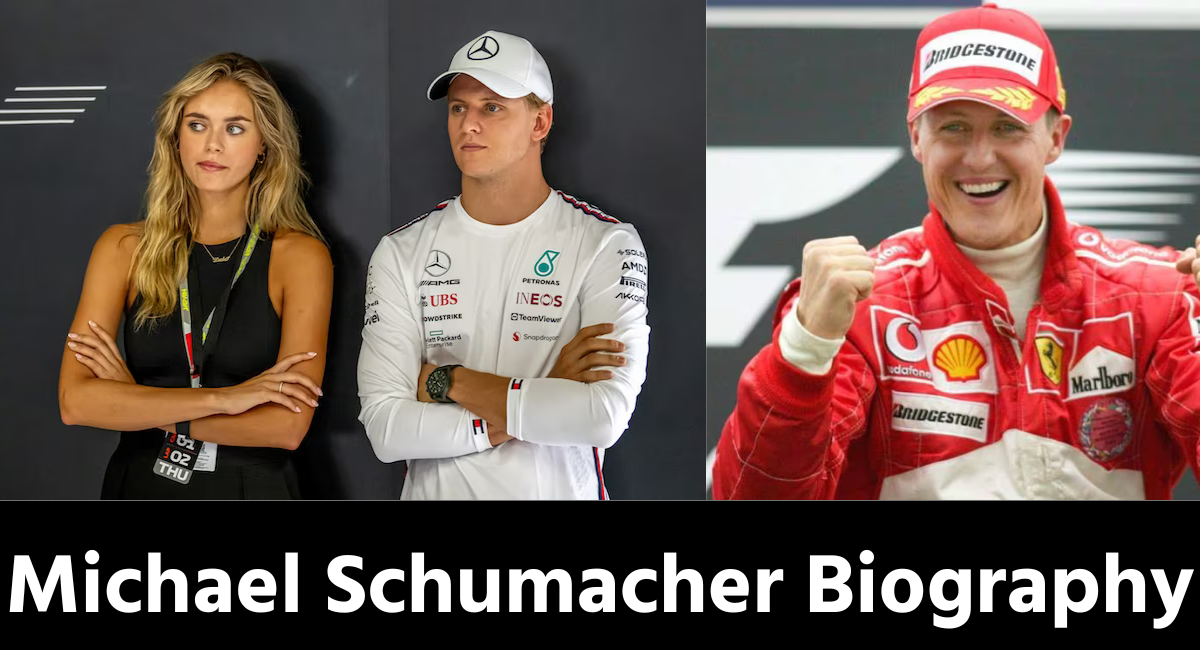Michael Schumacher born 3 January 1969 is a German former racing driver who competed in Formula One for Jordan, Benetton, Ferrari, and Mercedes. Schumacher has a joint-record seven World Drivers’ Championship titles (tied with Lewis Hamilton) and, at the time of his retirement from the sport in 2012, he held the records for the most wins pole positions and podium finishes which have since been broken by Hamilton—while he maintains the record for the number of total fastest laps among others.
Michael Schumacher Facts
- Born :3 January 1969 (age 54) 6 Hürth, North Rhine-Westphalia, West Germany
- Spouse: Corinna Betsch
- Children :Gina-Maria Schumacher
- Relatives: Ralph Schumacher (brother) David Schumacher (nephew) Sebastian Stahl (step-brother)
- Active years : 1991–2006, 2010–2012
- Teams Jordan, Benetton, Ferrari, Mercedes
- Engines Ford, Renault, Ferrari, Mercedes
Michael Schumacher Early years
Michael Schumacher was born in the West German town of Hürth, North Rhine-Westphalia, on 3 January 1969, to working-class parents Rolf—a bricklayer who later ran the local kart track—and Elisabeth Schumacher (1948–2003), who operated the track’s canteen.When Schumacher was four, his father modified his pedal kart by adding a small motorcycle engine. After Michael crashed it into a lamp post in Kerpen, his parents took him to the karting track at Kerpen-Horrem, where he became the youngest member of the karting club. His father built him a kart from discarded parts and, at the age of six, Schumacher won his first club championship. To support his son’s racing, Rolf took on a second job renting and repairing karts, while his wife worked at the track’s canteen. Nevertheless, when Michael needed a new engine costing 800 DM, his parents were unable to afford it; he was able to continue racing with support from local businessmen.
Regulations in Germany require a driver to be at least 14 years old to obtain a kart license. To get around this, Schumacher obtained a license in Luxembourg at the age of 12. In 1983, he obtained his German license, a year after he won the German Junior Kart Championship. Schumacher joined Eurokart dealer Adolf Neubert in 1985 and by 1987, he was the German and European kart champion, then he quit school and began working as a mechanic. In 1988, he made his first step into single-seat car racing by participating in the German Formula Ford and Formula König series, winning the latter.
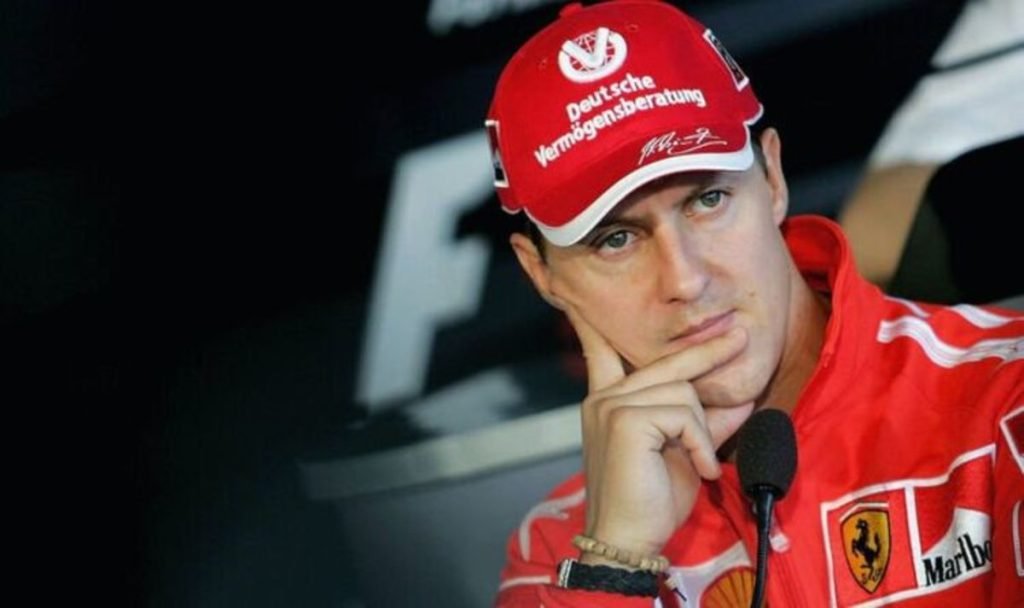
In 1989, Schumacher signed with Willi Weber’s WTS Formula Three team. Funded by Weber, he competed in the German Formula Three series, winning the title in 1990. He also won the 1990 Macau Grand Prix under controversial circumstances. He placed second behind Mika Häkkinen in the first heat, three seconds behind. At the start of the second heat, he overtook Häkkinen, who only had to finish within three seconds of Schumacher to clinch the overall win. In the closing laps, Schumacher made a mistake, allowing Häkkinen to attempt to overtake. Michael changed his line immediately before Häkkinen did the same as the latter moved to overtake, and Häkkinen crashed into the back of Schumacher’s car.While Häkkinen’s race was ended, Schumacher drove to victory without a rear wing. Schumacher gave the prize money from winning the race to his family as they had debts.
During 1990, along with his Formula Three rivals Heinz-Harald Frentzen and Karl Wendlinger, he joined the Mercedes junior racing programme in the World Sportscar Championship. This was unusual for a young driver: most of Schumacher’s contemporaries competed in Formula 3000 on the way to Formula One. However, Weber advised Schumacher that being exposed to professional press conferences and driving powerful cars in long-distance races would help his career. In the 1990 World Sportscar Championship season, Schumacher won the season finale at the Autódromo Hermanos Rodríguez in a Sauber–Mercedes C11, and finished fifth in the Drivers’ Championship despite only driving in three of the nine races. He continued with the team in the 1991 World Sportscar Championship season, winning again at the final race of the season at Autopolis in Japan with a Sauber–Mercedes-Benz C291, leading to a ninth-place finish in the Drivers’ Championship. He also competed at Le Mans during that season, finishing fifth in a car shared with Wendlinger and Fritz Kreutzpointner. In 1991, he competed in one race in the Japanese Formula 3000 Championship, finishing second.
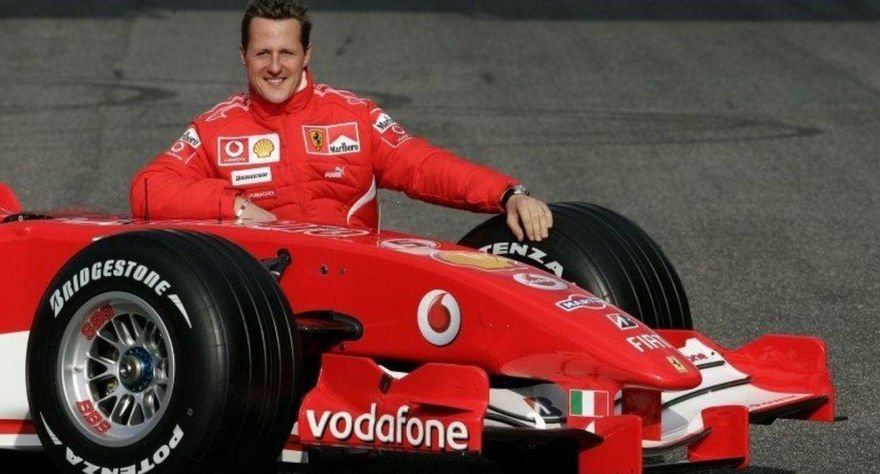
During the 1991 430 km of Nürburgring, Schumacher was involved in an incident with Derek Warwick. While trying to set his flying lap in qualifying, Schumacher encountered Warwick’s Jaguar on a slow lap resulting in lost time for Schumacher. As retaliation for Warwick being in his way, Schumacher swerved his Sauber into Warwick’s car, hitting the Jaguar’s nose and front wheel. Enraged by Schumacher’s attitude, Warwick drove to the pits and chased Schumacher on foot. He eventually caught up with Schumacher, and it took intervention from several mechanics and Schumacher’s teammate Jochen Mass to prevent Warwick physically assaulting Schumacher.
Michael Schumacher Formula One career
Schumacher was noted throughout his career for his ability to produce fast laps at crucial moments in a race and to push his car to the very limit for sustained periods He was also noted for his pioneering fitness regimen and ability to galvanise teams around him. In 2004, Slate magazine described Schumacher as “the ultimate driving machine” and “the most dominant athlete in the world” due to him having become “quicker, stronger, and fitter than the competition by outworking them in the weight room”.The magazine also stated that Schumacher changed the sport as he set a new benchmark for other drivers and built the team and technologies around him.Schumacher exercised four hours a day, mostly to strengthen his neck muscles to better withstand G-forces during races After his gym session, he would often head to the race track for testing.In 2003, Deutsche Welle highlighted Schumacher’s “natural talent” for racing and his “discipline and leadership”. In 2023, former Formula One rival Giancarlo Fisichella noted that Schumacher “did not even seem to have sweated” during races, adding that Schumacher is the greatest Formula One driver of all time and “rewrote the history of Formula One”.
In 2003, F1 Racing magazine analysed Schumacher’s driving style using telemetry data.It was noted that Schumacher was “very sensitively and flexibly” on the gas and brakes. Compared with his Ferrari teammate Rubens Barrichello, who often either braked or accelerated in a corner, Schumacher usually braked later into a corner and stabilised his car by accelerating slightly, often using both the brake and accelerator pedals at the same time. Exiting a corner, Schumacher accelerated considerably and balanced his car by braking lightly. With his driving style, Schumacher went 25 km/h faster through the hairpin corner of the Suzuka Circuit compared to Barrichello, who lost 0.3 seconds to Schumacher in this corner.It was also noted that when needed, such as when the brakes started to overheat, Schumacher adapted his driving style to protect the brakes.
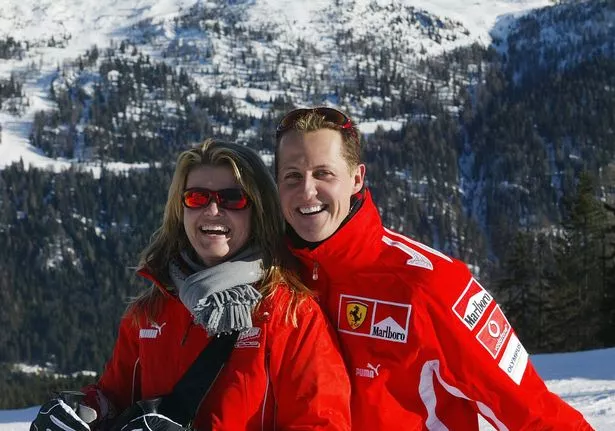
Michael Schumacher Motor Sport author Christopher Hilton observed in 2003 that a “measure of a driver’s capabilities is his performance in wet races, because the most delicate car control and sensitivity are needed”, and noted that like other great drivers, Schumacher’s record in wet conditions shows very few mistakes: up to the end of 2003, Schumacher won 17 of the 30 races in wet conditions he contested
Some of Schumacher’s best performances occurred in such conditions, earning him the nicknames “Regenkönig” (rain king)or “Regenmeister” (rain master), even in the non-German-language media. He is also known as “the Red Baron”, because of his red Ferrari and in reference to the German Manfred von Richthofen, the famous flying ace of the First World War. Schumacher’s nicknames also include “Schumi”,[19] “Schuey and “Schu”
Schumacher has often been credited with popularising Formula One worldwide, especially in Germany, where it was formerly considered a fringe sport. In a 2006 FIA survey, he was voted the most popular driver of the season among Formula One fans. Throughout his career, however, Schumacher was subject to anti-German prejudices, especially from the British media.When Schumacher retired in 2006, three of the top ten drivers in that year’s Drivers’ standings were German, more than any other nationality. Younger German drivers, such as Sebastian Vettel, felt Schumacher was key in their becoming Formula One drivers.In 2020, Vettel named Schumacher the greatest Formula One driver of all time.

During a large part of his Formula One career, Schumacher was the president of the Grand Prix Drivers’ Association.In 2006, Formula One rival David Coulthard hailed Schumacher as the greatest all-round racing driver in the history of the sport, while three-time World Champion Niki Lauda stated: “He is the greatest. Nobody will ever beat him, as long as we are alive”. In 2020, Schumacher was voted the most influential person in Formula One history.
Michael Schumacher Personal life and philanthropy
Michael Schumacher In August 1995, Michael married Corinna Betsch. They have two children, a daughter Gina-Maria (born 20 February 1997) and a son, Mick (born 22 March 1999). Schumacher has always been very protective of his private life and is known to dislike the celebrity spotlight. From late 1991 until May 1996, Schumacher resided in Monaco. The family moved to a newly built mansion near Gland, Switzerland, in 2007, covering an area of 650-square-metre (7,000 sq ft) with a private beach on Lake Geneva and featuring an underground garage and petrol station, with a vintage Shell fuel pump.Schumacher and his wife own horse ranches in Texas and Switzerland. Schumacher’s younger brother Ralf, his son Mick, his nephew David and step-brother Sebastian Stahl have also been racing drivers.Ralf Schumacher competed in Formula One for ten years, starting from 1997 until the end of 2007. Mick became the third Schumacher to race in Formula One, having made his debut with Haas F1 Team in the 2021 season.

Michael Schumacher Before his skiing accident, his main hobbies included horse riding, motorcycle racing, sky diving, and he played football for his local team FC Echichens.Schumacher appeared in several charity football games, and organised games between Formula One drivers. He is a supporter of 1. FC Köln, his local football club from where he grew up, citing Pierre Littbarski and Harald Schumacher as his idols. He is a Roman Catholic.
In 2006, Schumacher had a voice role in the Disney/Pixar film Cars. His character is himself as a Ferrari F430 who visits the town of Radiator Springs to get new tires from Luigi and Guido at the recommendation of Lightning McQueen. During arrival, Luigi and Guido both faint in excitement when they see him. The French film Asterix at the Olympic Games features Schumacher in a cameo role as a chariot driver called Schumix. In 2009, Schumacher appeared on the BBC’s motoring programme Top Gear as the Stig.Presenter Jeremy Clarkson hinted later in the programme that Schumacher was not the regular Stig, which the BBC subsequently confirmed. Schumacher was there because Ferrari would not allow anyone else to drive the unique black Ferrari FXX that was featured in the show. In July 2021, Netflix announced the first officially approved documentary film about Schumacher—called Schumacher—which was released on 15 September 2021.
Schumacher was a special ambassador to UNESCO and has donated 1.5 million euros to the organisation. Additionally, he paid for the construction of a school for poor children and for area improvements in Dakar, Senegal. He supported a hospital for child victims of the siege in Sarajevo, which specialises in caring for amputees.In Lima, Peru, he funded the “Palace for the Poor”, a centre for helping homeless street children obtain an education, clothing, food, medical attention, and shelter. Schumacher told F1 Magazine: “It’s great if you can use your fame and the power your fame gives you to draw attention to things that really matter”.For the 2002 and 2013 European flood disasters, Schumacher donated 1 million and 500,000 euros, respectively.He donated $10 million for aid after the 2004 Indian Ocean earthquake, which surpassed that of any other sports person, most sports leagues, many worldwide corporations and even some countries. From 2002 to 2006, he donated at least $50 million to various charities.In 2008, he donated between $5M and $10M to the Clinton Foundation.
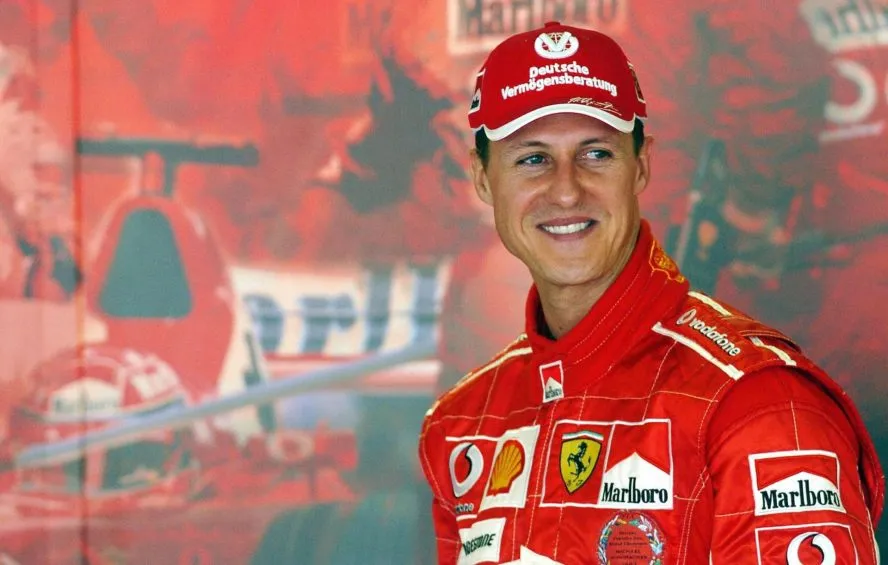
Michael Schumacher Since his participation in an FIA European road safety campaign, as part of his punishment after the collision at the 1997 European Grand Prix, Schumacher continued to support other campaigns, such as Make Roads Safe, which is led by the FIA Foundation and calls on G8 countries and the United Nations to recognise global road deaths as a major global health issue. In 2008, Schumacher was the figurehead of an advertising campaign by Bacardi to raise awareness about responsible drinking. He featured in an advertising campaign for television, cinema and online media, supported by consumer engagements, public relations and digital media across the world.

